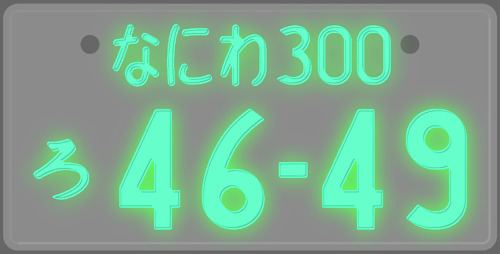 | ||
In Japan, the national government issues vehicle registration plates for motor vehicles through the Ministry of Land, Infrastructure, Transport and Tourism Land Transportation Offices nationwide. However, the local municipality rather than the national government registers certain vehicles with small engine displacements. Broadly speaking, passenger automobiles with engine displacements at or smaller than 2000 cc receive 5-series plates, while passenger automobiles with engine displacements larger than 2,000 cc (120 cu in) or more receive 3-series license plates. The number on the top line begins with a "0" through "9" to indicate the series, followed by additional numbers for specific vehicle classification. Additional criteria include a numerical representation signifying length, width and height of the vehicle. Official vehicles of the Imperial household are exempt from the requirement to display such plates. Official vehicles of the Self-Defense Forces, foreign diplomats, and the U.S. military are required to display other plates.
Contents
The plates are installed on both the front and rear of the vehicle, with the rear plate permanently attached to the vehicle with a prefecture seal completely covering one of the attaching plate bolts. The plate is only removed when the vehicle has reached the end of service and has been sold for scrap, or exported. New vehicles are not delivered to the purchaser until the plates have been attached at the dealership.
Since November 1, 1970, a "jiko-shiki" (字光式) plate has been offered for private vehicles at the owner's request. The green characters on this type of plate are replaced with molded green plastic that can be illuminated from behind the plate. From May 19, 1998, specific numbers can also be requested if the numbers are not already in use. From 2010, these are also available in blue.
Appearance
* These plates are issued by municipal governments.
Until 31 December 1974, kei cars had small green and white license plates. After this date, they received medium plates, now in black and yellow to distinguish them from regular cars.
Please note that, to avoid any claims of invasion of privacy, the artist of these pictures has deliberately selected an invalid combination of characters.
The illustration shows what a plate might look like. The top line contains the name of the issuing office (Tama, shown, is in Tokyo) and a vehicle class code. The bottom line contains a hiragana character and a four-digit serial number divided into two groups of two digits separated by a hyphen. Any leading zeros are replaced by centered dots.
White plates can have the following hiragana (blue indicates rental vehicle characters):
さすせそたちつてとなにぬねのはひふほまみむめもやゆよらりるろれわ
Green plates can have the following hiragana:
あいうえかきくけこを
Some characters, including ones with a dakuten or a handakuten, cannot be used on any plates, including the yellow and black ones:
'ばだがぱざびぢぎぴじぶづぐぷずべでげペぜぼどごぽぞゑゐ
A license plate in Japan thus follows this format: KK?*H##-## (e.g., 足立500き21-41), where KK is the name of the issuing office in kanji, H is a hiragana, ? is a 5 for vehicles less than 2000 cc and a 3 for vehicles greater than 2000 cc (other numbers are less common—1 for large trucks, 2 for buses, etc.), * is a number from 0 to 99 (pre-1971 license plates will omit this), and # is a number from 0* to 9 (*leading zeros are replaced by centered dots).
Special use plates
Vehicles owned by personnel with the United States military in Japan under the Status of Forces Agreement (SOFA) have a "Y" on white plates, or an "A" on yellow plates, where the hiragana character is normally displayed. Earlier versions of the SOFA license plate displayed the letters "K", "M", "G", "H" and "E". These letters indicated the car was imported into Japan under SOFA and was left-hand drive. Today, cars with an "E" indicate that Japanese sales tax has not been paid and the vehicle will not remain in Japan when the military member departs. Since the 1980s, military commands have discouraged servicemembers assigned to Japan from shipping their vehicles from the U.S. into the country, so this is rarely seen. Military members who retire in Japan use the hiragana "よ". Many opt to purchase second-hand domestic vehicles through used car dealers off-base, and from other servicemembers departing Japan at on-base "lemon lots".
Out of country plates
Because the Japanese writing system, particularly the kana, is unique to Japan, standard-issue Japanese license plates are considered unacceptable for international travel. If a motorist wishes to take their vehicle abroad with them, the Ministry of Transport will issue them with a plate with the hiragana and kanji scripts replaced by Roman letters. The hiragana prefix is replaced by a Kunrei-shiki romanization of that character. The kanji prefecture/office code is replaced by a two- or three-letter abbreviation, the first two letters representing the prefecture, the third (if present) representing the office within the prefecture. All the numerical portions of the plate remain the same.
Using the example given above, the plate (足立500き21-41) would then read TKA 500 KI 21-41 (TKA for Tokyo Adachi).
Transportation offices and markings
In 2006, several new location names, known as Gotōchi (ご当地, local place) numbers, were approved by the MLIT for places that wanted to increase their recognition for purposes such as tourism. Criteria included the need for 100,000 vehicles in the area and the avoidance of an imbalance in the prefecture. The new locations began appearing in 2006 on plates for vehicles registered in certain specific cities, towns and villages in or near the places marked below in green.
